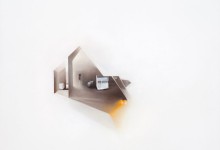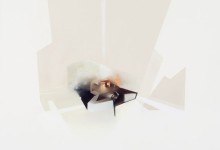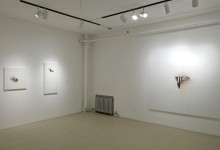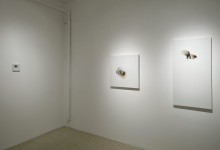The Poetry of Space in Magalie Comeau’s Paintings
Text by Marsha Taichman
Magalie Comeau is an explorer. She finds spaces and scrutinizes them, taking time to mull over and dissect them in her mind. She then thoughtfully re-pieces these sites on her canvases. Rather than capturing the walls and floors of a building as they would appear in three-point perspective, Comeau twists and turns architecture, cross-sectioning and bending interiors outwards while further complicating her multifaceted horizons by subdividing the rooms, confusing inside and outside. They are dizzying propositions, and when she claims to have been visually overloaded from her investigations, I am not inclined to argue. She looks at how bodies (her own and others) interact with space, how we react and respond to the places that we inhabit. She thinks of these physical structures as distinct personalities that she is responding to, and that these skewed rooms become presences akin to people.
These paintings evoke the city, its buildings and inhabitants. They are also reminiscent of the city’s grit, its dust clouds and the sprays of graffiti so prevalent in urban environments. Yet other images seem tranquil, dusky and domestic. Comeau does not choose one particular type of place to dissect and repurpose. In her recent work Le vertige de l’architactrice, the centre of the image is a room with diffuse natural light and hardwood floors, evoking some kind of habitable structure. The setting is so welcoming that it becomes familiar.
The execution of Comeau’s paintings is stunning, demonstrating a patient craftsmanship. She paints with oil in order to build complex colours and smooth blending. One element of her oeuvre that is extremely striking is her capacity for hard-edged painting. To achieve such sharp lines and well-defined shapes with oil is becoming increasingly rare in contemporary painting.
Comeau’s paintings offer glorious juxtapositions of hard and soft, with their narrow corners and walls protruding into nowhere. They are improbable floor plans, with bursts of cloud and shadow obscuring the clean geometry of the sites. Greys and muted tones are shocked with unexpected regions of bright colour. These pops of red or blue or green become the focal points of the works. These paintings do not seem grounded in any reality that I have experienced, and yet I am inclined to try to unscramble each locale and try to discern what makes each canvas (and, by extension, each space depicted) so uncanny and disembodied while they are still warm with human presence.



















